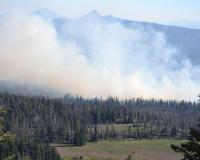
Vibrant Environment
Pollution Control
All | Biodiversity | Climate Change and Sustainability | Environmental Justice | Governance and Rule of Law | Land Use and Natural Resources | Oceans and Coasts | Pollution Control

On October 2, approximately 25,000 gallons of oil spilled into the Pacific Ocean from a pipeline off the shore of Huntington Beach in Orange County, California. While the full environmental impact of the spill is still under investigation, it is clear that the oil spill threatens the money, time, and effort that have gone into rehabilitating and maintaining nearby wetlands. Dead fish and birds were seen washing up on shore. Oil now coats the rocky beach.

“The United States has a very effective liability management policy and legal framework, but that same framework has some unintended consequences for the circular economy,” including risk aversion that can create barriers to circular economy businesses, said John Lovenburg, Vice President of Environment at BNSF Railway, in his opening remarks as moderator of ELI’s fourth GreenTech webinar March 24, 2021, on “The Emerging Circular Economy.”

One voter in seven believes that Hillary Clinton is running a cabal of satan-worshipping cannibalistic pedophiles. A member of Congress charges that last year’s wildfires in the western states were caused by Jewish space lasers. A U.S. senator insists that China aims to breed a race of super soldiers by harvesting visiting athletes’ DNA when it hosts the winter Olympics in 2022. The Ohio legislature recently heard testimony alleging that the Covid vaccines are magnetizing people. According to a 2012 survey, one in four members of the U.S. public does not know the Earth orbits the Sun. A poll by the Associated Press in 2014 found that four in ten Americans dispute evolution and half do not believe the Big Bang theory.

As summer approaches, school systems throughout the United States are planning for in-person and hybrid learning next fall. Since the beginning of the pandemic, Congress has appropriated $190 billion to assist those efforts; the recent American Rescue Plan Act alone provides around $122 billion for PK-12 public education.

The coronavirus pandemic has focused increased attention on indoor air quality and ventilation. Yet, many people remain unaware of the health risks posed by an activity that occurs every day in their homes: cooking.

The agricultural industry is developing fast. With new and emerging technologies on the rise, industrial agriculture continually strives to incorporate sustainability and efficiency into its operations. Although the industry produces significant pollutants, including animal waste, chemical fertilizers, pesticides, and other agricultural inputs and byproducts, incorporating new technologies, such as drones, helps to mitigate the hazardous pollutants associated with industrial agriculture. In addition to mitigating environmental harm, incorporating sustainable technology into agricultural practices can improve water conservation and bolster efficiency.

Per- and polyfluoroalkyl substances, a class of toxic synthetic chemicals collectively known as PFAS, are all around us—in the environment and in our bodies. According to the Agency for Toxic Substances and Disease Registry, most people in the United States have PFAS in their blood. Scientific studies have shown that exposure to these “forever chemicals” can lead to a variety of adverse health effects, including increased cholesterol, pregnancy complications, and kidney and testicular cancers; recent studies also suggest that PFAS may reduce resistance to infectious diseases such as COVID-19 and may reduce antibody responses to vaccines.

The Deepwater Horizon exploded in the Gulf of Mexico more than 10 years ago. Yet hundreds of individuals across the Gulf coast are still battling BP in court for damages related to a host of ailments arising from exposure to oil, dispersants, or both. A recent order out of the Northern District of Florida (N.D. Fla.) granting BP’s summary judgment motion as to one set of plaintiffs may be a sign of things to come. Regardless of this ruling, the sheer volume of these cases may occupy dockets for months or years.

Nearly all the pollutants in our everyday environment can be found easily — albeit less problematically — when one leaves our planet’s surface. Ozone is the most ironic example, restricted at ground level and protected above. And the atmospheres of Mars and Venus are mostly carbon dioxide, which at least in our atmosphere, where it is only a trace gas, the Supreme Court says it can nonetheless be mitigated under the Clean Air Act.

On August 5, 2015, EPA personnel assigned to mitigate pollutants from the foreclosed Gold King Mine in Colorado caused the discharge of toxic wastewater into the Animas River watershed, releasing lead, arsenic, and other metals and toxic elements. Even though Colorado Governor Hickenlooper eventually declared the area a disaster zone, the delayed response and devastating environmental impacts from the Gold King Mine wastewater spill revealed an urgent need to address the nearly 500,000 Abandoned Mine Lands throughout the United States. According to the EPA, the total cost to clean up AMLs ranges from $50-70 billion. Although the burden of mitigating toxic pollutants from AMLs may appear to rest solely upon the federal government, the Comprehensive Environmental Response, Compensation, and Liability Act (CERCLA) mandates that the party responsible for AML hazardous contamination must assume financial responsibility.